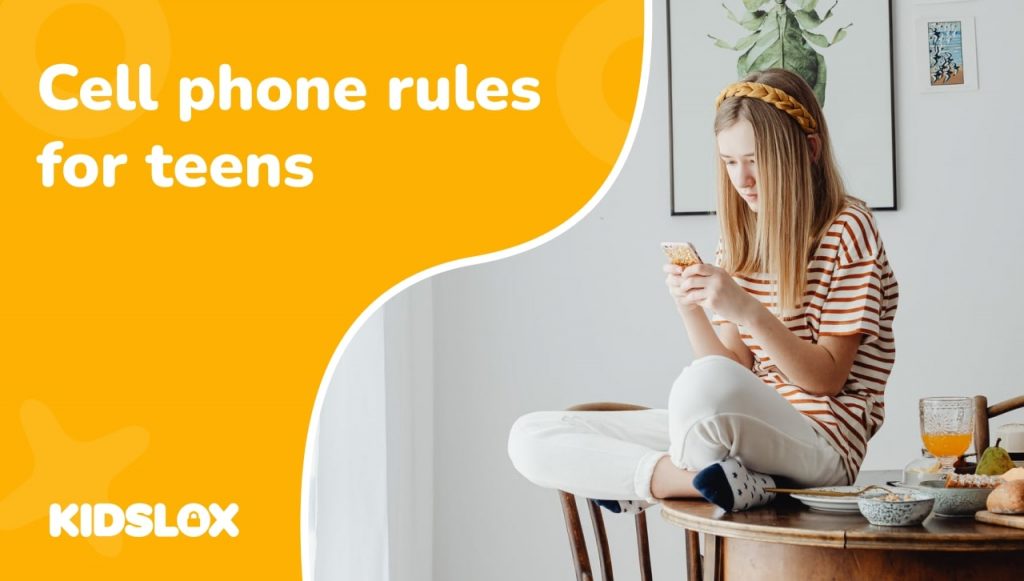Parents, teenagers and experts all over the world have concluded that smartphones are the most influential means of communication among young people, as well as a key platform for spending their leisure time. While some researchers don’t find this situation alarming, others advocate that parents need to get cell phone usage under control to minimize the potential for problematic situations. So when you buy a gadget as a present, it’s probably a good idea to introduce some cell phone rules for teens, you can read a few ideas below. Implementing them might be not as easy as it sounds though. As ever with rules and teens, you’ll need to be ready to stand by the rules and consequences you set.
Where to start?
To start with, let’s clarify two key issues for parents before introducing a new mobile phone policy to the rest of the family.
First, keep in mind your child imitates everything you say and do. Sometimes it might not seem like your teen is taking their cues from you, but they are. Ultimately your example is the biggest one they have and their understanding of what’s normal or what’s acceptable is founded in what they see you doing. If you take calls while driving, don’t expect your teen to behave any differently. Secondly, where possible establish the rules from the first day you give the cell phone to your child. These rules should come naturally and be accepted as ‘this is the way the things are done in our family’. If you come up with a list of rules in response to bad behaviour they’re often seen as a punishment rather than the norm.
5 basic cell phone rules for teens to be observed
Rule #1 No mobile phones in the bedroom at night time
Why is this important? Proper sleep is extremely important for teenagers and their healthy growth. Sleep habits influence the quality of sleep. Moreover, sleep patterns are shaped when kids are growing and can then last into their adult years. It’s amazing how much sleep is lost due to mobiles. Teens often stay up later if they have their phone handy, chatting or playing till the small hours. Perhaps even worse, a huge number of teens wake in the night to check notifications or messages or to check into online games. No wonder they’re exhausted in the morning and find it hard to concentrate at school. Better to leave phone usage for daytime.
What is the best way to enforce the rule? Everybody in the family (parents too) should put their mobile phones in one place, let it be the kitchen or living room. The devices can be charged overnight. Be an example and start observing the rule yourself first. Often we excuse the bedtime presence of mobiles as “it’s our alarm clock”. It doesn’t have to be. Buy an alarm clock that isn’t a mobile phone, it doesn’t have to be expensive.
Potential child’s reaction: Your teen might use the same excuse, so get them an alarm clock too. They might also object that their friends are allowed to use mobiles at night. Emphasise the reason for the rule (phones distract from good sleep which is important for being effective and getting the most out of your day), point out your own compliance with the rule and if needed fall back on good ole “I’m not responsible for your friends, but I am responsible for you”.
Rule # 2 Follow school cell phone rules
Why is this important? Usually, each school works out their own policy in terms of cell phone usage. Get familiar with the rules your school has in place and let your child know that they are expected to obey them. Not only will following these rules keep them on the right side of their teachers and enable them to focus on their school work properly, but it also puts them in good stead for potential college or employment positions with similar policies.
What is the best way to enforce the rule? If you want to make certain your child doesn’t use the phone at all when at school, you could have them leave it at home. They could collect it as soon as they come back from lessons. If on the other hand, you’d prefer to be able to keep in touch with your teen during school time, you might want to use parental control software like Kidslox to block entertainment apps according to the pre-set schedule while leaving the ability to call or text you if necessary.
Potential child’s reaction: If your teen finds this rule hard to accept, point them back towards the school rules. You didn’t make those up, you’re just helping your child to stick to them.

Rule #3 No mobiles during family time
Why is this important? Perhaps you’ve noticed that your teen can’t put down their phone and interact with you during dinner, family days or any other kind of family time? If you want to spend quality time together as a family, without interference from texting, gaming or liking Instagram pictures, let that time be device-free.
What is the best way to enforce the rule? One way to help make sure this rule works is to make sure that “family time” is well defined. If mealtimes are always family time and phones aren’t allowed during family time, the rule isn’t left with too many vague grey boundaries for teens to push at. Some people like to have a special phone box where all family members store their mobiles while eating. If you’re going out somewhere together, have them leave their devices in the car once you reach your destination.
Potential child’s reaction: Meal times are the classic situation for the old “let me just finish this level” or “5 more minutes mum, please”. Where possible give a warning a few minutes before you want them to come so that they know their time is coming to a close.
Rule #4 No picture messaging
Why is this important: Teens today snap photos of everything and this might be a hard rule for some to accept. Visual communication has become a key part of modern messaging, which is why you may not want to use this rule with your teens. If you want to place an emphasis on safety though, note that some statistics suggest 39% of teens have sent sext messages containing explicit images. Not only does this behaviour leave them especially vulnerable to bullying and blackmail if the receiver shares the images or threatens to do so, but it can also even lead to cases of online grooming and other predatory behaviours.
What is the best way to enforce the rule: If you basically trust your teen in this area, you might just want to explicitly reserve the right to occasionally look through their social media accounts. This just acts as a reminder that if they wouldn’t want you to see something, they shouldn’t be posting it to anyone else either. If you want to try and place an all-out ban on picture messaging it’s actually quite challenging to completely enforce. Try using parental controls to block the device’s camera or to make sure that apps whose sole function is picture messaging don’t get installed
Potential child’s reaction: This rule is likely to get a lot of kickback from some teens and almost none from others. You’ll need to decide whether the hard or light version of the rule is more appropriate in your case. If they demonstrate a certain amount of responsibility in this area and an understanding of the risks, be willing to become more flexible with this rule to allow them to join in with peer communication.
Rule # 5 Check if all phone contacts are real friends or members of the family
Why is this important? Kids often have over 300 random contacts in their cell phone address book and think nothing of it. Handing over contact details seems to have become the first thing people do on making a new acquaintance. Children, in particular, are often eager to give their number to all their classmates as well as more distant acquaintances they hardly know. All of those people can then easily get in touch with your kids at any time.
What is the best way to enforce the rule? When your child is at a high school you’d hope that they’re mature enough that you can trust them to be sensible about who they add to their contact list. It’s not always the case though. In this case and while they’re still tweens, you should definitely look through their list every once in a while. On top of that, encourage them to spring clean their social media friends list every once in a while. If they can’t remember who a person is, if they’ve never met the person in real life or if they’ve never once had written communication with someone, chances are they shouldn’t be in that friend’s list. You might want to consider having a similar spring clean of your own contacts…
Potential child’s reaction: If you introduce a rule like this at the same time they get their first phone, it’s likely to be an accepted part of phone ownership. If you introduce it later on it might meet a little more resistance. Remind them about the dangers posed by internet predators and emphasise that the size of their friends’ list is no reflection of what they’re like as a person. It’s far better to have a small group of real friends in your list than thousands of unknown strangers.
Introducing cell phone rules for teens
One way you could try introducing some of the rules suggested above is to create a cell phone contract for teens containing all the rules along with the results of breaking them. Try setting these rules in conversation with your teen about what they think is reasonable. However, you establish the rules, make sure that you explain some of the reasoning behind them so that your teen understands that they’re not rules for the sake of rules but that they have specific aims to assist and protect them.
We use a parental control app. Especially if you notice that mobile phones or tablets have become a source of tension in your family, an app blocker for Android or iOS can help block games or social media apps for a while and prevent unauthorised use. Even if the question of screen time is solved by other means, good parental control apps offer content filters and other child protection measures too.

Digital hygiene
Internet services and social media open us a whole new world in many senses. This world is filled with numerous opportunities for personal growth and education, for business and fun. But the digital dimension can be not only destructive but also formative. And we are not talking just about viruses and malware. Some social media relations we have can be very toxic and some internet discussions may cause us to lose our peace of mind. Therefore we need some rules of “digital hygiene” to resist internet trolling, haters and cyberbullying or internet swindlers.
Young people and kids are among the most vulnerable. Previous generations usually had some socialization experience in real life before becoming internet users. And modern children learn how to socialize directly in the net, and this is where their first social experience comes from. At least 1/3 of all the teenage kids have been cyberbullied on social media and more than 2/3 faced slander and gossip being spread online about them which has a very negative effect on their mental health and social skills.
Digital hygiene rules
Just like simple basic rules of physical hygiene (like wash your hands, brush your teeth, take shower regularly etc.) will help you to stay healthy and productive and to avoid many diseases, several simple rules of digital hygiene will make your digital life much healthier and productive.
Trolling vs critique
First of all, you need to distinguish between trolling and hating from real critique. We cannot see people’s faces and emotions through our screens. And sometimes what we might consider as trolling or attack us can be just a piece of advice but given in the unsuccessful form. So when you are not sure about the true intentions of your internet vis-à-vis do not presume the worst.
Keep your house clean
Do not allow dirty talks on your Facebook page and in the comments to your posts. Some people start right away with offensive speech, rude comments and dirty jokes. You probably would not allow such a behaviour in your home. Well, consider your social media page your ‘digital home’ and block internet trolls from accessing it.
Do not fight somebody’s battle
Do not break the spears in comments to somebody’s article, social media post or other content and do not let to engage you in online disputes so easily. The best way to support and promote an alternative view on anything you disagree with is to create your own content of good quality. By doing this you will not only make your social media account or web page better and brighter but will make social media a better place in a sense.
Communicate online just like you would communicate in real life
Try to communicate with people online the same way you would communicate with them in real life. Many people consider social media and forum chat the permissiveness area because there is no big chance that the verbal conflict may grow into something greater. But even though there is almost no chance that for you would cross with your online opponent in a real life, other internet users see your comments and can make their own conclusions about you. This may cost you something in future. In our highly digital world, many people can see your account profile and professional agencies can check it as well. And aggressive comments in social media can turn into a disadvantage when you try to get a position in a respected company.
Do not turn into “plastic person”
Some people’s social media accounts represent “perfect life”. Expensive cars, best resorts, Michelin three-star restaurants, selfies with celebrities, etc. They are called “plastic people”. Being very selfish, they usually would do anything to achieve their goals of wealth or personal status, including using and humiliating others. Those accounts do not look very attractive for average users but do attract internet trolls.
Check the source of the information
Do not succumb to social media hysteria when people start to repost some “sensation” or fake news. Tarry extra couple minutes and Google the news to see if the content you are about to post is valid. If you cannot find the source easily wait couple hours – somebody will probably check it and share the finding.
Protect your personal information
Protecting personal information is one of the key things why you are online. Many passwords can be easily hacked, and intruders may get access to your accounts violating your privacy and stealing your money or identity. To protect personal information when using the internet you should, avoid suspicious links and visit only reputable sites.
You should also consider using special software for safe browsing. Proper security setting of your browser and antivirus or firewall program will make your online experience pleasant and much safer. When it has to do with your children’s safety and digital hygiene, parental control solution will be very helpful. The main issue of digital hygiene is the same as of the physical one. If we practice it regularly it will develop into a good habit that will make our digital life healthier, easier and more pleasant.

How to Say ‘No’ to your Child
“Daddy, please, can I play some more?.. Please, one more cartoon!.. Please, let’s download one more game!..” Sometimes we give up and feel like a softie, or we firmly insist on the rules and think of ourselves as cruel tyrants. Suppose you get tired of your child’s everlasting nagging and decide to do something about it. You download a parental control app, set time limits on your child’s device and block the content you want to protect your child from. That’s exactly what Kidslox can do. Do you think that’s the end of the issue though?
Well, it is and it isn’t. Yes, your child is now protected from inappropriate content, yes they can now only use their device at the times you set. But be prepared to continue hearing, “Daddy, please change the time limits!.. I know it’s bedtime, but please, unlock my tablet so I can finish this game…” And so on and so forth… How come?
But how can we say ‘no’ and not feel bad about ourselves? Some parents seem to have no struggle with this at all, others seem so conflicted about it they end up providing very little protection for their kids at all. I found the following tips on how to say ‘no’ to our kids very helpful:\
- Once you’ve said ‘no’, it should stay ‘no’, regardless of whether your child is asking for the 2nd, 20th or 200th time. This is one reason why it’s good to sit and discuss the screen rules you want to enforce with your child before installing Kidslox. Ideally, they should agree with you that the rules sound reasonable. Then when their device turns off at 8pm (according to a schedule you’ve set) and they come running to ask for more time, you can say, ‘no, remember what we agreed, no games after 8pm’. Saying ‘yes’ at that point would show that the rules you’ve set are meaningless.
- Once you’ve decided to say ‘no’ to your child (even if they’ve agreed with you about the need for the rule) prepare for a bit of a battle before the rule becomes the norm. Forbidden things are often the most desirable. Your child will want to break the rule and it will need confirming and enforcing several times before it really sinks in.
- Do not be afraid of your child’s anger. It doesn’t mean that they don’t love you any more. It just means they can’t completely control their emotions. Which is why we need the next tip…
Be patient! And the next one… - Don’t give up!
- Respect your child and control your own emotions. Try not to criticise, make fun of or be angry with them. Instead show that you understand the reason they’re upset, but insist on the rules agreed upon.
- Support your child’s attempts to follow your ‘no’s. Quite often we pay attention to what’s doing wrong, but say nothing when everything’s on track. Kid’s love praise! Point out how pleased you are when they follow a rule you have in place.
- Both parents should be in the know and in agreement about the rules in place. Sometimes though, it’s just not possible to discuss your position on something in advance. In which case a simple “What did mom/dad say?” can help keep things consistent if you encounter new situations.
A parental control app can effectively regulate how your child is using their gadget but it can’t regulate your relationship, or completely remove the relational tension created when you deny them something they want. You remain the parent and your ‘no’ is still the ultimate instrument of parental control. That’s why parental controls need to be applied as part of a wider conversation about what your child is and isn’t allowed to do and why.




